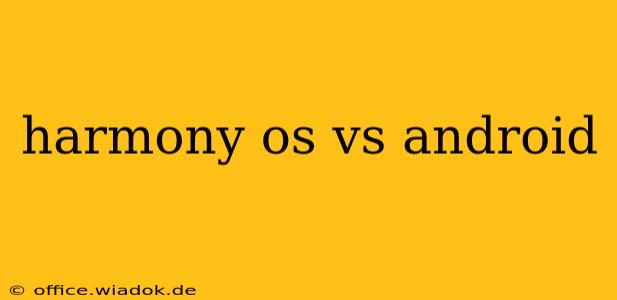The mobile operating system (OS) landscape is dominated by Android and iOS, but a significant contender is emerging: HarmonyOS. Developed by Huawei, HarmonyOS is a full-fledged operating system designed to power a wide range of devices, from smartphones and tablets to smartwatches and even cars. But how does it stack up against the ubiquitous Android? This in-depth comparison will explore the key differences and similarities between HarmonyOS and Android, helping you understand which OS might be right for you.
Key Differences: A Head-to-Head Comparison
While both HarmonyOS and Android are based on a Linux kernel, their architectural designs and functionalities diverge significantly. Here's a breakdown of their core differences:
1. Architecture: Distributed vs. Monolithic
Android: Employs a traditional monolithic architecture. Applications run in their own isolated sandboxes within the operating system, resulting in potential fragmentation and less efficient resource utilization across devices.
HarmonyOS: Utilizes a distributed architecture, a key differentiator. This allows for seamless interoperability between different devices. Imagine effortlessly transferring a video from your phone to your smart TV with minimal latency – this is the power of HarmonyOS's distributed architecture. Applications can seamlessly access resources across multiple devices, enhancing user experience and streamlining multitasking.
2. Development and Ecosystem: Open vs. More Closed
Android: An open-source platform with a vast developer community and a massive app ecosystem – the Google Play Store. This openness fosters innovation but also introduces potential security concerns.
HarmonyOS: While based on open-source components, Huawei maintains more control over its ecosystem. While the app ecosystem is growing rapidly, it's not yet as extensive as Android's. Huawei is actively encouraging developers to port their Android apps to HarmonyOS using tools and resources to ease the transition. This more controlled approach might lead to a more consistent user experience but could limit the availability of certain apps.
3. User Interface (UI) and User Experience (UX): Familiar yet Different
Android: Known for its customizable UI and vast range of customization options. The user experience varies depending on the device manufacturer and the Android skin applied.
HarmonyOS: Presents a clean, modern UI, offering a user-friendly experience. While it shares some similarities with Android, its emphasis on multi-device collaboration and distributed capabilities offers a unique UX. The emphasis is on seamless transitions and intuitive interactions across the connected device ecosystem.
4. Privacy and Security: Different Approaches
Android: Google's involvement brings both advantages and disadvantages concerning privacy. While Google provides regular security updates, data collection practices have been a subject of debate.
HarmonyOS: Huawei focuses on privacy and security features, offering greater control over user data. However, the relative newness of the OS means its long-term security track record is yet to be fully established.
HarmonyOS Strengths: Where it Excels
- Seamless Cross-Device Collaboration: The standout feature is its ability to connect and interact smoothly with various devices in a unified ecosystem.
- Enhanced Performance: The distributed architecture can potentially lead to improved performance and resource management compared to a traditional monolithic approach.
- Focus on Privacy: Huawei prioritizes user privacy and data security.
Android's Advantages: Why it Remains Dominant
- Massive App Ecosystem: The Google Play Store offers an unparalleled selection of apps.
- Mature Ecosystem and Support: Years of development and a vast community ensure strong support and a wealth of resources for developers and users alike.
- Wide Device Compatibility: Android powers a vast range of devices from various manufacturers.
The Verdict: Choosing the Right OS
The "better" OS depends heavily on your priorities. Android's mature ecosystem and extensive app library make it the clear winner for most users. However, if you prioritize seamless cross-device interaction and a focus on privacy within a more integrated ecosystem, HarmonyOS presents a compelling alternative, particularly within the Huawei device ecosystem. The future of HarmonyOS is promising, but its success hinges on expanding its app ecosystem and gaining wider global adoption. As it evolves, it will likely pose a more significant challenge to Android's dominance.

